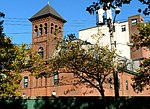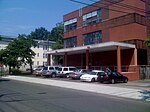Dr. Mary B. Moody House
Houses completed in 1875Houses in New Haven, ConnecticutHouses on the National Register of Historic Places in ConnecticutNational Register of Historic Places in New Haven, ConnecticutQueen Anne architecture in Connecticut

The Dr. Mary B. Moody House, also known as Chetstone, is a historic house at 154 East Grand Avenue in New Haven, Connecticut. Built in 1875, it is one of the city's finest examples of residential Carpenter Gothic architecture, and was home to Dr. Mary Blair Moody, one of the first female physicians to practice in the city. The house was listed on the National Register of Historic Places in 2017.
Excerpt from the Wikipedia article Dr. Mary B. Moody House (License: CC BY-SA 3.0, Authors, Images).Dr. Mary B. Moody House
East Grand Avenue, New Haven
Geographical coordinates (GPS) Address External links Nearby Places Show on map
Geographical coordinates (GPS)
| Latitude | Longitude |
|---|---|
| N 41.306778 ° | E -72.881734 ° |
Address
East Grand Avenue 154
06513 New Haven
Connecticut, United States
Open on Google Maps







